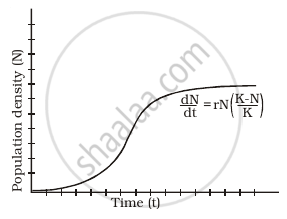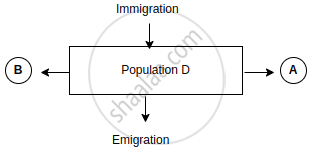Advertisements
Advertisements
प्रश्न
Which one of the following is not a push factor?
विकल्प
Water shortage
Medical/Educational facilities
Unemployment
Epidemics
उत्तर
Medical/Educational facilities
Explanation:
Conditions in migrants' home countries make it difficult or even impossible for them to live there, whereas "pull" factors in the destination country make it a more appealing place to live than their home countries.
APPEARS IN
संबंधित प्रश्न
Examine the following statement and correct the incorrect one.
Greater economic prosperity indicates the development of a region.
Give Geographical Reason.
The real progress of a country is understood with the help of the Human Development Index.
Identify the correct correlation :
A: Assertion; R: Reasoning
A: In stage 2, the death rate reduces but the birth rate is constant.
R: The population increases rapidly in stage 2.
Give a geographical reason:
Population may increase though birth rates are low.
India’s population as per 2011 census is:
What are the three components of population change?
Push factors and pull factors of migration.
What is the impact of migration?
What is population growth? What does population change indicate for an area?
Distinguish between the place of origin and the place of destination.
How many stages/phases of population growth?
What was the population of India as per the 2011 Census?
In how many years India's population will be doubled?
What is the average sex ratio In India (2011)?
The continent that has the highest growth rate of population.
Population increased by the difference between births and deaths in a particular region between two points of time.
Which one of the following is not a component of population change?
How many times the world population has increased during the last 500 years?
What is the present growth rate of population in the world?
Which of the following is not a push factor for migration?
The ten most populated countries have a ______ world population.
Which of these statements is not true?
Which of the following attributes has not been adversely affected by Age and Skill selective migration?
Consider the following statements and choose the correct option from the given options:
1. Population grown rapidly during the sixteenth and seventeenth centuries.
2. Expansion of world trade during the sixteenth and seventeenth centuries is an important cause of it.

Which is not in stage III?
On the basis of the demographic data of a country given below, construct an age pyramid and explain whether the population is stable, declining or growing.
| Age group | No. of individuals |
| Pre-reproductive | 20,000 |
| Reproductive | 15,000 |
| Post-reproductive | 10,000 |
Ratio between mortality and neutrality is called ______.
In an exponential bacterial culture, the number of cells/ml is plotted o half log group. The growth is ______.
Which of these is a major cause of female migration in India?
What would be the per cent growth or birth rate per individual per hour for the same population mentioned in the previous question (Question 10)?
What would be the growth rate pattern, when the resources are unlimited?
Comment on the growth curve given below.


Observe the schematic representation given above and answer the following questions:
- Identify A and B.
- Calculate the growth rate of bacteria in a curd sample, where 1 million bacteria increased to two million, within a period of one hour.
Examine the different aspects of the growth of population in India during 1951-1981 and 1981-2021.
Consider the following and choose the correct answer with the help of given codes-
| STAGES OF POPULATION | GROWTH FEATURES |
| I Period between 1901 to 1921 | 1. Period of steady growth |
| II Period between 1921 to 1951 | 2. Phase of stagnant growth of Population |
| III Period between 1951 to 1981 | 3. High but decreasing growth rate |
| IV After 1981 till present | 4. Period of population explosion |
Assertion (A): Population of a region does not change.
Reasoning (R): Birth rate, death rate and migration affect the population of a region.
Assertion (A): Population of a region does not change.
Reasoning (R): Birth rate, death rate and migration affect the population of a region.
Assertion (A): The population of a region does not change.
Reasoning (R): Birth rate, death rate and migration affect the population of a region.
A: Population of a region does not change.
R: Birth rate, death rate and migration affect the population of a region.
A: Assertion; R: Reasoning
A: The population of a region does not change.
R: Birth rate, death rate and migration affect the population of a region.
Assertion (A): Population of a region does not change.
Reasoning (R): Birth rate, death rate and migration affect the population of a region.
Assertion (A): Population of a region does not change.
Reasoning (R): Birth rate, death rate and migration affect the population of a region.
Assertion: Population of a region does not change.
Reason: Birth rate, death rate and migration affect the population of a region.
Assertion: Population of a region does not change.
Reason: Birth rate, death rate and migration affect the population of a region.
Assertion (A): Population of a region does not change.
Reasoning (R): Birth rate, death rate and migration affect the population of a region.
Define the following term:
Growth rate of population
Assertion (A): Population of a region does not change.
Reasoning (R): Birth rate, death rate and migration affect the population of a region.
